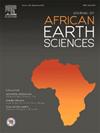Zircon and Titanite U-Pb geochronology, petrology and P-T path of garnet-bearing amphibolites from Tadoumet area (Assodé-Issalane terrane, Central Hoggar, Algeria)
IF 2.2
4区 地球科学
Q2 GEOSCIENCES, MULTIDISCIPLINARY
引用次数: 0
Abstract
The garnet-bearing amphibolites of the Tadoumet area (Assodé-Issalane terrane, Orosirian Stripe, Hoggar), show three principal metamorphic stages. (i) A pre-peak metamorphic stage, characterized by mineral inclusions of quartz, plagioclase, epidote, rutile, and titanite encapsulated within garnet porphyroblasts (M0); (ii) A relatively high-grade stage, represented by a coarse-grained paragenesis comprising garnet porphyroblasts, amphibole, clinopyroxene, quartz, titanite, and rutile (M1); (iii) A retrograde stage, marked by the development of amphibole‒plagioclase‒K-feldspar coronae assemblages around garnet with titanite (M2).Microprobe analysis indicates that garnet compositions range between XAlm = 0.47–0.58, XGr = 0.25–0.35, and XPy = 0.06–0.16. Clinopyroxenes exhibit zoning, with cores depleted in Mg relative to the rims (XMg core = 0.57, XMg rim = 0.65). Furthermore, amphibole associated with the M1 stage displays compositions indicative of magnesio-hornblende, whereas the M2 stage is characterized by magnesian-hastingsite coronae (Si < 6.25 and XMg = 0.4–0.6). Tschermakite, with XMg values of 0.51–0.60, is found in association with clinopyroxene and plagioclase (XAn = 0.34–0.48).Calculated P-T pseudosections suggest peak P–T conditions of 13.5 ± 1 kbar and 700 ± 50 °C (M1), characterizing a mineral assemblage comprising hornblende, diopside, garnet, K-feldspar, plagioclase, rutile, titanite, and melt, based on garnet core compositions. Additionally, decompression stage corresponds to high temperature conditions (750 ± 50 °C, M2a) followed by cooling (600 ± 50 °C, M2b) at 6.5 ± 1 kbar, using the compositions of garnet rims, secondary diopside, amphibole, and plagioclase isopleths and Ti in amphibole geothermometer. This study constitutes the first geochronological investigation of metamorphism in the Tadoumet area, utilizing in situ U–Pb dating of zircon and titanite. The findings indicate a protolith age of 712 ± 20 Ma (derived from zircons) and an amphibolite-facies metamorphic age of 599 ± 4 Ma (obtained from titanite). The P–T trajectory recorded in the garnet-bearing amphibolites is interpreted as reflecting a distinct sequence of continental collision, in which crustal thickening denotes the peak of metamorphism, followed by decompression driven probably by extensional processes.
阿尔及利亚中部Hoggar assod - issalane地块Tadoumet地区含石榴石角闪岩锆石和钛石U-Pb年代学、岩石学及P-T路径
Tadoumet地区含石榴石角闪岩(assod - issalane地体,俄罗系条纹,Hoggar)表现出三个主要变质期。(i)峰前变质阶段,特征是石英、斜长石、绿帘石、金红石和钛矿包裹在石榴石卟绿母岩中(M0);(ii)相对高级的阶段,以粗粒共生为代表,包括石榴石卟啉母岩、角闪孔、斜辉石、石英、钛矿和金红石(M1);(iii)逆行阶段,在含钛的石榴石(M2)周围发育角闪石-斜长石-钾长石日冕组合。微探针分析表明,石榴石组成范围为XAlm = 0.47 ~ 0.58, XGr = 0.25 ~ 0.35, XPy = 0.06 ~ 0.16。斜辉石岩具有明显的分带性,岩心相对于岩缘的Mg含量较低(XMg岩心= 0.57,XMg岩心= 0.65)。此外,与M1阶段相关的角闪孔显示出镁-角闪石成分,而M2阶段的特征是镁-速生位日冕(Si <;6.25, XMg = 0.4-0.6)。锆石与斜辉石、斜长石的XMg值为0.51 ~ 0.60,XAn = 0.34 ~ 0.48。计算得到的P-T伪剖面显示峰值P-T条件为13.5±1 kbar和700±50°C (M1),根据石榴石岩心组成,其矿物组合包括角闪石、透辉石、石榴石、钾长石、斜长石、金红石、钛矿和熔体。此外,根据石榴石边缘、次生透辉石、角闪洞、斜长石等长石组成和角闪洞Ti的地温计,减压阶段对应于高温条件(750±50°C, M2a),然后在6.5±1 kbar下冷却(600±50°C, M2b)。本研究首次利用锆石和钛矿原位U-Pb测年对塔杜梅地区的变质作用进行了年代学研究。原岩年龄为712±20 Ma(来自锆石),角闪岩相变质年龄为599±4 Ma(来自钛矿)。在含石榴石角闪岩中记录的P-T轨迹被解释为反映了一个明显的大陆碰撞序列,其中地壳增厚标志着变质作用的高峰,随后是可能由伸展作用驱动的减压。
本文章由计算机程序翻译,如有差异,请以英文原文为准。
求助全文
约1分钟内获得全文
求助全文
来源期刊

Journal of African Earth Sciences
地学-地球科学综合
CiteScore
4.70
自引率
4.30%
发文量
240
审稿时长
12 months
期刊介绍:
The Journal of African Earth Sciences sees itself as the prime geological journal for all aspects of the Earth Sciences about the African plate. Papers dealing with peripheral areas are welcome if they demonstrate a tight link with Africa.
The Journal publishes high quality, peer-reviewed scientific papers. It is devoted primarily to research papers but short communications relating to new developments of broad interest, reviews and book reviews will also be considered. Papers must have international appeal and should present work of more regional than local significance and dealing with well identified and justified scientific questions. Specialised technical papers, analytical or exploration reports must be avoided. Papers on applied geology should preferably be linked to such core disciplines and must be addressed to a more general geoscientific audience.
 求助内容:
求助内容: 应助结果提醒方式:
应助结果提醒方式:


